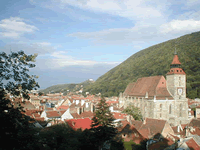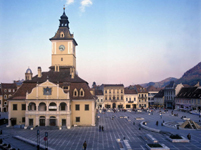The origins of Brasov as medieval town are lost in the dark times.
Archaeological discoveries mention life on this land since the Bronze
Age, 60,000 years ago. The most impressive monument of the Antiquity is
the Dacian Sanctuary of Racos, hardly accessible to tourists. Another
testimony of life on this land is the Roman camp discovered in Rasnov,
the former Northeastern border of the Roman empire.

An inscription in
stone reveals the ancient Dacian name of the land: Cumidava. The
Dacian-Roman settlements (Brasov, Harman, Cristian, Feldioara) in this
area stand proof that after the Romans retreat (the year 271) the
inhabitants (Daco-Roman population) remained on this land. However the
first documentary attestation dates back from the year 1234, when the
town was mentioned as CORONA. At that time the town was situated on the
present location of the Black Church. Later on the town was known as
Brasco, Brasso, Kronstadt or Brassovia Citadel.
Due to its geographical position, at the
crossroads of Moldavia and Valachia, Brasov has had a fast economic
growth, becoming one of the most important markets in Transylvania. On
the 14th century Brasov became one of the most economical and political
strongholds in the Southeast of Europe and on the 16th century also a
cultural center. Johannes Honterus, a great German humanist, worked
most of the time in Brasov and Deaconu Coresi printed the first
Romanian book also in Brasov.

On March, 1600, Mihai Viteazul visited Brasov and
summoned "The Diet of Transylvania" recognizing the rights of Tara
Birsei's inhabitants.
In 1688 when the Austrian army conquered Transylvania, Brasov was the
last Bastion standing. 1689 was a one of the toughest years in the
history of Brasov. On April, 21, a big fire destroyed most of the town
and killed 3,000 people. Most of the houses were destroyed and the
monument Saint Maria, smoked by the fire, will become "The Black
Church". Still hopeful, the citizens rapidly rebuild the city.
In 1838 George Baritiu edited the first Romanian
publications in Brasov: "Gazeta de Transilvania" and the "Paper for
Mind, Heart and Literature". It was also issued a literary review that
was promoting the Romanian writers and poets in Transylvania.
In the period following the 1st World War, Brasov
became a strong economical center in Europe, but the town was partly
destroyed during the 2nd World War. It was rebuilt and the historical
buildings were repaired.